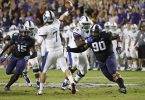If the NCAA Tournament selection committee wanted to describe this season’s Big 12 Conference, it would be as a “dad bod” – thinning up top and too thick in the middle.
The Big 12 has only itself to blame for letting itself go. Selection Sunday produced more disappointment that buzz. After placing seven of its 10 schools in the bracket in four of the last five seasons, 2019 will feature “just” six teams.
Even more damning is the fact that the conference’s highest-seeded team is regular-season co-champion Texas Tech. The Red Raiders are a No. 3 seed in the West Regional.
It’s the first time since 1999 that the Big 12 doesn’t have a team seeded No. 1 or No. 2. Over the last 22 seasons, the league has had 26 teams that were seeded No. 1 or No. 2.
Selecting the at-large teams this season brought mystery and intrigue. The Ratings Percentage Index (RPI) was buried as an evaluation tool and was replaced by the NET (NCAA Evaluation Tool). Its formula includes game results, strength of schedule, game location, scoring margin (capped at 10 points per game), and net offensive and defensive efficiency.
How much impact the NET had on the committee’s decisions is a great unknown. But whether using the RPI or the NET, Selection Sunday always ends up with the talking heads pointing out the mistakes and Dickie V screaming about the “little guys getting screwed.”
The Big 12 basically wasn’t a talking point. The NET ranked the conference’s six NCAA teams like this: Texas Tech, 10; Kansas, 20; Iowa State (automatic bid), 21; Kansas State, 24; Oklahoma, 37; Baylor 39.
The 10-member selection committee has a challenging job in deciding which 34 terms deserve an at-large invitation. When it comes down to a handful of teams for the last one or two positions, it’s an absolute – the teams they pick celebrate and the teams they don’t bitch.
Welcome to Big-Time Basketball, TCU. You found yourself with your nose pressed up against the window. The Frogs’ roster was decimated by injuries and departures and they finished the season with a seven-man rotation. They also lost five of their last seven to finish 20-13 overall. TCU, seeking back-to-back NCAA trips for the first time since 1953, started 12-1 before the season slipped away.
The Frogs and their fans have legitimate gripes. TCU spent the last two weeks bubbling on life support. The misfortune happened when three conferences produced unexpected automatic bids. Saint Louis won the Atlantic 10 and regular-season champion VCU (NET 34) earned an at-large invite. St. Mary’s stunned Gonzaga in the West Coast Conference championship game, giving that league two bids.
Late Saturday night, Oregon ran regular-season champion Washington off the floor to grab the Pac-12 tournament title and automatic bid. The Pac-12 has been putrid all season and for most of the last two months it appeared the league wouldn’t have any worthy at-large teams. Instead, the Pac-12 earned two at-large invites – Washington and Arizona State.
The last four at-large teams to make the field were Belmont (26-5, NET 42) of the Ohio Valley, Temple (56 NET) of the American Athletic, Arizona State (63 NET) and St. John’s (73 NET) of the Big East. Based on the NET numbers, the Frogs (52 NET) can argue they were more deserving.
The NET is broken down by victories in four quadrants and a team’s record is calculated in those four sections based on where the game was played. Quadrant 1: Home 1-30, Neutral 1-50, Away 1-75; Quadrant 2: Home 31-75, Neutral 51-100, Away 76-135; Quadrant 3: Home 76-160, Neutral 101-200, Away 135-240; Quadrant 4: Home 161-353, Neutral 201-353, Away 241-353.
Now that your eyes are bleeding, here’s how TCU compared with St. John’s in terms of records in the four quadrants:
St. John’s had 10 victories combined in Q1 and Q2 plus five Q3 losses. The Frogs had a combined nine victories in Q1 and Q2 and no losses in Q3 or Q4. TCU had nearly as many quality victories as St. John’s and no “bad” losses.
Had the Frogs earned a bid, they would have done so with a 7-11 Big 12 record. Oklahoma, the No. 9 seed in the South Regional, also finished 7-11 in league play. The Sooners are one of four teams invited despite losing league records – Minnesota (9-11), Ohio State (8-12) and St. John’s (8-10).
Last season, a record five at-large teams were selected despite being under .500 in league play. Oklahoma and Ohio State are the third and fourth teams to make it despite being four games under .500. The Big Ten Conference played a 20-game schedule this season and the Buckeyes’ 12 conference losses are the most for an at-large team.
Texas is playing in the NIT for the first time since 1986, and fourth-year coach Shaka Smart enters Tuesday’s game against South Dakota State with a 66-66 record in Austin. The Longhorns provided an interesting test case for the committee.
No team has ever been selected as an at-large with a .500 overall record or 16 losses. But 19 of the Longhorns’ games came against teams in the top 50 of the NET and they have victories over NCAA teams North Carolina, Purdue, Kansas, Kansas State, Iowa State, Oklahoma and Baylor. UT is No. 30 in the KenPom.com rankings. In the last 18 years, that’s the highest ranking of a team with a .500 record.
But unlike TCU fans, Orangebloods have nothing to complain about. The committee made the correct decision in not making history.
The Big 12 had three teams make successful NCAA runs last season. Kansas reached the Final Four while Texas Tech and Kansas State lost in regional finals. As a 10-team conference in 2012, the Big 12 has placed 64 percent of its teams in the bracket over the last eight seasons.
But it’s still been since 2008 that the league has won a national championship. Its two most recent Final Four appearances (Kansas last season, Oklahoma in 2016) resulted in flip-the-channel blowout defeats.
Despite putting teams in the bracket, over the last 10 years the Big 12 has 79 NCAA victories. That trails the Atlantic Coast (103), Big 10 (97) and Big East (96). Those three conferences plus the Southeastern have more Final Four appearances than the Big 12 over the last decade.
While the RPI is no longer used by the NCAA, it’s still a ratings method that is calculated. This will be the fifth time in the last six seasons that the Big 12 will finish on top. KenPom.com also ranks conferences and it has the Big 12 No. 2 behind the Big Ten (which placed eight teams in this year’s bracket.
If Microsoft ran college basketball’s post-season, the Big 12 would be the all-powerful king of the sport. Unfortunately, in a digital world, the Big 12 is analog.







